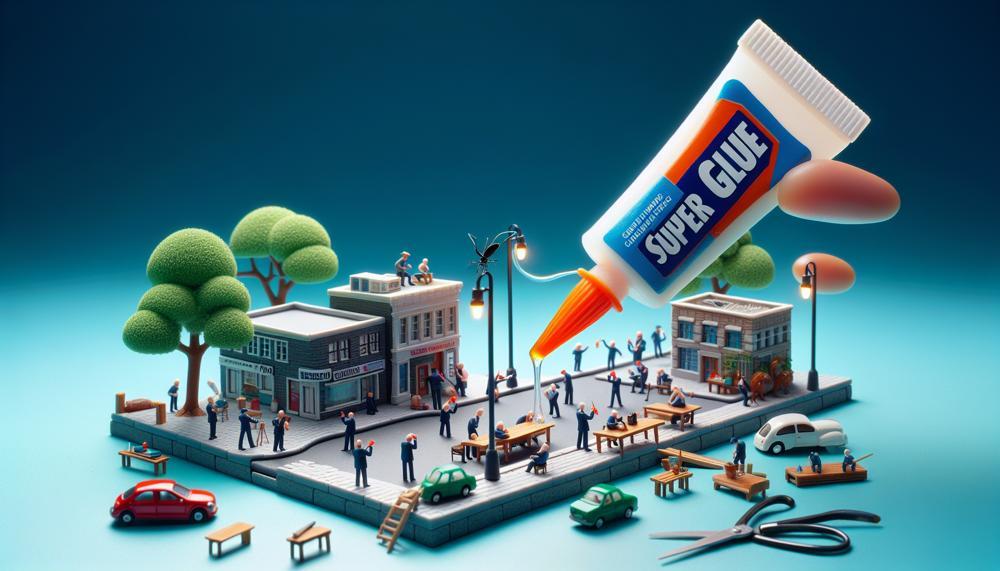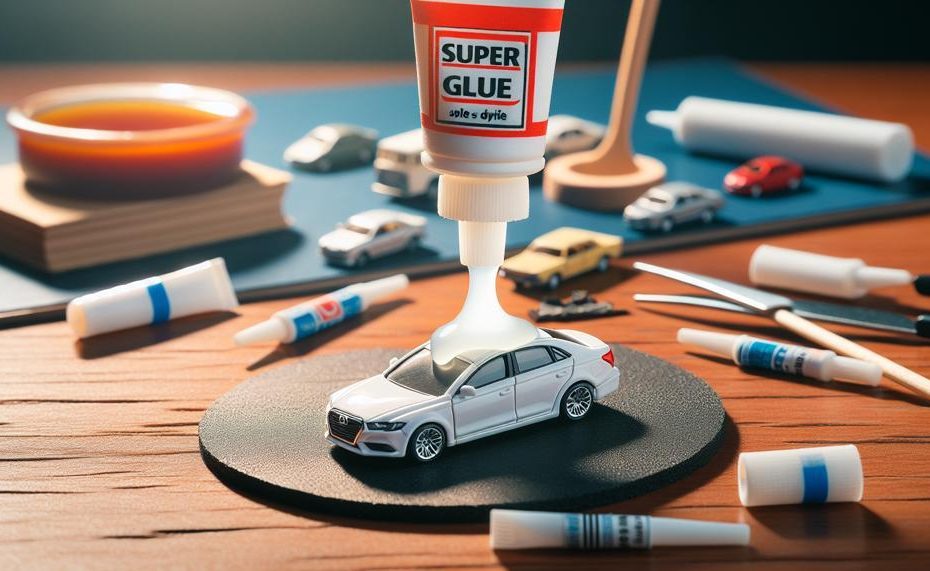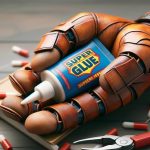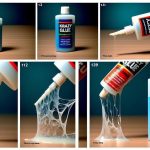Are you tired of sitting around, watching paint dry? Or in this case, super glue? In this blog post, we’ll share some tips and tricks on how to speed up the drying process of super glue. Say goodbye to long wait times and hello to quick and efficient bonding.
We’ve got you covered with these key points:
- Proper application is key: Learn the importance of precise application – using just the right amount of glue in the right spot can significantly decrease drying time.
- Accelerate your bonding: Discover how specialized accelerators for super glue can cut down on waiting time and get your project done faster.
- Heat it up or press it down: Find out how applying heat or pressure can activate the adhesive and reduce drying time.
- Choose wisely: Different types of super glue have varying drying times. We’ll help you choose the best one for your project.
With these tips in hand, you’ll be able to save time and get your projects done faster than ever before.
So let’s dive in and learn how to make super glue dry in a flash.
Table of Contents
- 1 What is Super Glue?
- 2 Why Speed Up the Drying of Super Glue?
- 3 Using Accelerators to Speed Up the Drying of Super Glue
- 4 Applying Heat to Speed Up the Drying of Super Glue
- 5 Adding Moisture to Speed Up the Drying of Super Glue
- 6 Ensuring Proper Ventilation to Speed Up the Drying of Super Glue
- 7 Using Thinner Layers to Speed Up the Drying of Super Glue
- 8 Safety Guidelines for Speeding up the Drying of Super Glue
- 9 Conclusion
What is Super Glue?
Super glue, also known as cyanoacrylate adhesive, is a powerful binding agent. It creates strong bonds between surfaces. Harry Coover discovered it in 1942. He originally intended to create a transparent plastic for gunsights. However, he soon realized its potential as a glue. Its use expanded into various industries.
The unique composition of super glue allows it to form bonds upon exposure to air moisture. This triggers a chemical reaction that hardens the glue. It creates a strong bond between surfaces.
With just one square inch of surface area, super glue can hold over a ton of weight.
To fully understand how super glue works, it’s essential to know the following steps:
- Preparation: Before applying super glue, it’s crucial to ensure that the surfaces are clean and dry. Any traces of moisture or debris can weaken the bond.
- Application: A small amount of super glue is carefully applied to one surface, followed by firmly pressing the two surfaces together. The glue will start to set within a matter of seconds.
- Drying: Super glue dries quickly on its own, but there are ways to speed up the process. Using an accelerator or activator specifically designed for super glue can help it dry in mere seconds. Heat can also accelerate the drying process, but caution must be taken to avoid damaging materials.
- Bonding: The bond formed by super glue is incredibly strong and capable of holding together various materials such as metal, plastic, wood, and rubber.
Super glue is a versatile adhesive that is commonly used for household repairs and industrial applications. However, safety should always be a top priority when handling super glue, and it’s crucial to carefully follow instructions for best results.
Keep in mind that when working with super glue, proper preparation is key. Ensuring that the surfaces are clean and dry before application will result in a stronger bond. Additionally, using an accelerator or activator and carefully controlling the drying process can also improve the bond’s strength.
Although super glue is a convenient and powerful adhesive, it’s important to handle it with caution.
Avoid contact with skin and eyes, and always follow instructions for safe use.
Why Speed Up the Drying of Super Glue?
Speeding up the drying process of super glue can have numerous benefits. These include saving time, creating a stronger bond, increasing versatility, enhancing precision, and providing convenience.
- One of the most significant advantages of accelerating the drying process is saving time. Super glue usually takes several minutes to dry. But, using an accelerator like baking soda can reduce drying time to mere seconds. This can be especially useful in time-sensitive situations where you need the bond to form quickly.
- Furthermore, using an accelerator like baking soda can create a stronger bond between surfaces. The baking soda acts as an activator and helps the glue cure faster and more efficiently. This results in a more durable and long-lasting bond, making it ideal for various applications.
- By reducing the drying time of super glue, it becomes more versatile and useful for a wider range of projects. It can be used for quick repairs, bonding materials together, and even in arts and crafts projects. This versatility makes super glue a valuable adhesive to have on hand.
- Another benefit of speeding up the drying process is precision. When using super glue, precision is crucial. By accelerating the drying process, you have more control over the bond formation and can ensure that the surfaces are perfectly aligned before the glue sets. This results in a more precise and secure bond.
- Lastly, having a faster-drying super glue means less waiting time and more convenience. You can quickly finish your projects without having to wait for the glue to dry, making it an ideal choice for busy individuals.
Using Accelerators to Speed Up the Drying of Super Glue
When it comes to super glue, the drying process can often be time-consuming.
That’s where accelerators come in. These handy tools work by increasing the rate of chemical reactions that occur during the drying process of super glue.
By reacting with the glue, accelerators help it dry and bond faster, resulting in a stronger and quicker bond between surfaces. In addition, accelerators have other benefits. They regulate the consistency and thickness of the glue, making it easier to work with and apply precisely.
They can prevent air bubbles or other imperfections from forming in the bond, ensuring a smooth and flawless result. Additionally, accelerators can increase the versatility of super glue. They allow it to bond to a wider range of materials, including plastics and rubber.
This makes them an essential tool for any DIY enthusiast or professional. They are looking for convenience and efficiency in their projects.
Applying Heat to Speed Up the Drying of Super Glue
Applying heat can significantly decrease the drying time of super glue. This is because warmer temperatures cause the molecules in the glue to move faster, allowing them to bond more quickly. You can achieve this by using a hair dryer on low heat or placing the glued object near a radiator.
However, it’s important to be cautious with the amount of heat used. Too much can weaken the bond or cause cracks in the glue.
| Benefits | Drawbacks | Expert Advice |
| Accelerates bonding process by increasing molecular movement in glue | Excessive heat can result in weakened bond or cracks in glue | – Use low heat from a hair dryer or radiator for best results – Avoid excessive heat that may harm the bond – Always follow manufacturer’s instructions for optimal performance |
Adding Moisture to Speed Up the Drying of Super Glue
To speed up the drying process of super glue, one can add moisture to provide more “fuel” for the glue to react with. This results in faster curing, as super glue cures through a reaction with moisture in the air.
By introducing additional moisture, the glue receives a “turbo boost” and cures even quicker.
- Provides more “fuel” for the glue to react with
- Speeds up the curing process
- Gives the glue a “turbo boost”
- Cures through a reaction with moisture in the air
- Introducing additional moisture
- Works best when added immediately after applying the super glue
There are various ways to add moisture:
- Use a water mister or work in a humid environment
- It is important to use proper ventilation when adding moisture and working with super glue.
- Excess moisture can lead to longer drying times and weaker bonds.
Other factors that contribute to faster drying include:
- Using thinner layers of super glue.
- Choosing the right type of accelerator or activator specifically designed for super glue.
- For optimal results, it is recommended to follow safety precautions and work in a well-ventilated area.
- Adding moisture to speed up the drying process of super glue can be beneficial. It provides more “fuel” for the glue to react with, resulting in faster curing.
- Super glue cures through a reaction with moisture in the air. Introducing additional moisture gives it a “turbo boost” and speeds up the process.
It is important to note that adding moisture works best when done immediately after applying the super glue.
There are various ways to add moisture, such as using a water mister or working in a humid environment.
However, it is essential to use proper ventilation when adding moisture and working with super glue. Excess moisture can lead to longer drying times and weaker bonds. It is crucial to follow safety precautions and work in a well-ventilated area for optimal results.
Other factors that contribute to faster drying include using thinner layers of super glue. Also, choosing the right type of accelerator or activator, specifically designed for super glue.
Ensuring Proper Ventilation to Speed Up the Drying of Super Glue

Proper ventilation is essential for drying super glue faster. By introducing fresh air and reducing moisture, the chemical reaction that causes the glue to harden is sped up. This results in a quicker bond.
This is because the evaporation of water molecules helps activate the cyanoacrylate molecules in the glue, causing them to bond together faster.
Not only does ventilation speed up the drying process, but it also prevents excess moisture from building up. When there’s lots of moisture in the air, it can create a barrier between the glue and the surface it’s trying to bond. This hinders the drying process. With proper ventilation, this barrier is minimized, allowing for better contact and a stronger bond.
When working with super glue, choose a well-ventilated area with natural airflow or use fans or air conditioning to ensure optimal ventilation. This will provide a consistent supply of fresh air to speed up the drying process.
In addition to ventilation, heat can also be used to expedite the drying time of super glue. Applying heat helps water molecules evaporate faster. It also activates the cyanoacrylate molecules in the glue. However, it is crucial to use caution when applying heat as too much can weaken the bond.
Using thinner layers of super glue can also contribute to faster results. Thinner layers dry quicker due to their smaller surface area, allowing for a faster reaction between the molecules.
Using Thinner Layers to Speed Up the Drying of Super Glue
When trying to speed up the drying process of super glue, using thinner layers can be beneficial in several ways.
- First, thinner layers have less moisture to evaporate, making them dry faster than thicker layers. Additionally, proper application is crucial as using too much glue can significantly prolong drying time. Therefore, it is essential to use just enough adhesive for speedy results.
- Another option to speed up the curing process is to use accelerators and activators specifically designed for super glue. These products contain chemicals that initiate a chemical reaction, allowing the glue to dry in seconds instead of minutes.
- Heat application can also accelerate drying by evaporating moisture from the glue. However, it is essential to use caution when applying heat, as excessive heat can damage delicate materials or weaken the bond strength.
- Choosing a cyanoacrylate adhesive over regular super glue can also result in faster drying times.
- In addition to using proper techniques and products, maintaining proper ventilation is crucial for quick drying. Fresh air helps reduce moisture levels and promote air circulation, allowing for faster drying times.
- It is also essential to prioritize safety measures when working with super glue. This includes wearing protective gear and following the manufacturer’s instructions carefully.
Safety Guidelines for Speeding up the Drying of Super Glue
To ensure safety while speeding up the drying of super glue, follow proper guidelines and techniques.
First, wear protective gear like gloves and eyewear. This is essential to avoid potential hazards. Additionally, make sure to work in a well-ventilated area to prevent inhaling harmful fumes.
When applying super glue, it is important to follow the manufacturer’s instructions for optimal usage. This includes using thin and even layers of glue for faster drying. Be cautious when using super glue on sensitive surfaces.
Before applying the glue, ensure that the surfaces are clean and dry. Exercise patience by allowing sufficient time for the glue to dry naturally.
It is also crucial to read and adhere to all safety warnings provided by the manufacturer. These precautions are summarized in the following:
- Wear protective gear
- Follow manufacturer’s instructions
- Work in a well-ventilated area
- Apply thin and even layers
- Be cautious on sensitive surfaces
- Ensure surfaces are clean and dry
- Allow adequate drying time
- Read and follow safety warnings
In addition to these precautions, proper techniques must be used when applying super glue for optimal results. This includes firmly holding the surfaces together for at least 30 seconds to ensure a strong bond.
To speed up the drying process without compromising bond strength, use accelerators or activators designed specifically for super glue.
Also Read: How To Make Super Glue Dry Faster?
Conclusion
In conclusion, the key to making super glue dry faster lies in proper application techniques. Use accelerators or activators. Apply heat or pressure. Choose the right type for your project.
These methods not only save time but also provide a stronger bond. Safety should always be a top priority. Be sure to wear protective gear and work in a well-ventilated area. Also, follow the manufacturer’s instructions.
Say goodbye to long wait times and hello to fast and effective results with these tips at hand.






